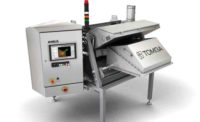Ingredient-handling equipment used by snack producers and bakeries ranges from automated batching and dosing machines to pneumatic conveyors, as well as equipment like sifters to prepare ingredients for addition to batches of dough.
These machines streamline plant efficiency and improve throughput. Snack and bakery operations are also looking to save money while improving safety.
Market demands
Customers of VAC-U-MAX, Belleville, NJ, are always looking to make incremental improvements in a variety of areas, such as accuracy, sanitary design and operator safety, says David Kennedy, business development manager. “They want predictable performance. They want control over what’s going on. They want to know all the materials we’re using are food grade, bumper-to-bumper, and they want proof of that. There’s definitely more interest in combustible dusts and more awareness as people move from old equipment to new, that you need to bring combustible dust compliance into the conversation.”
Vacuum systems also help manufacturers shift to more dry cleaning sanitation procedures. Municipalities are starting to monitor wastewater systems more closely, says Kennedy. They want food companies to stop washing so much down the drain. He notes that one option is to vacuum up waste and sell it as byproduct for use in animal feed.
Operations cost reductions remain a perennial issue for customers of AZO Inc., Memphis, TN, but injury risk and operator safety have been a quickly growing concern, says Zach Turner, sales engineer. “People are more urgently investing in bulk systems or more automated systems to avoid the unloading of bags to avoid injury.”
FSMA has increased awareness and concern, Turner says. “People are looking to transfer ingredients directly, in one pass.” Otherwise, ingredients are taken back to a storage vessel, such as flour that’s circulated back into the top of the silo, which is all material that’s not traced, he says.
Equipment suppliers have also been developing sophisticated, automated process controls accessible via smartphone, Turner says. “They want to be notified ahead of time if they need more material. They don’t want to have somebody have to do the math.”
Sanitary equipment that allows for the ease of maintenance and inspection is top of mind for customers of Great Western Manufacturing, Leavenworth, KS, according to Katrina Cirusse, marketing coordinator. Brooke Dessert, technical sales manager, adds that Great Western customers want efficient cleaning and maintenance processes that do not disrupt equipment.
Customers of WD Laramore Manufacturing, Thomasville, GA, have sought to reduce the costs of both compressed air and labor, and they have wanted equipment that’s both more efficient and quieter, says Bill Laramore Jr., owner and CEO. The desire to reduce costs has probably generated 75 percent of changes, he estimates.
The Fred D. Pfening Co., Columbus, OH, has noticed an uptick in requests for vacuum conveyors and bulk bag unloaders, says Bill Kearns, chief engineer emeritus. “We’re seeing a lot of bulk bag unloaders but not very many requests for hand dump bins like in the late 1990s and early 2000s.”
Ingredients streamlined
The Pfening Co. has unveiled a bulk bag unloader that automatically discharges into an air conveying system or mechanical feeder. The unit comes with a hoist and trolley to lift the bags into position, a heavy-duty frame and sanitary design built to BISSC standards. The unloader is regularly customized, Kearns says.
Pfening also produces the Enviro-Blender automatic temperature blender and metering system, aimed at large bakeries, which modulates the blending valve at every moment throughout the draw to achieve the desired temperature. The unit meters water accurately within 0.2 percent, wastes no water in reaching the desired temperature, saving time, energy and money. Kearns notes a new model will be at IBIE this fall featuring upgraded software and the ability to respond even more quickly to temperature changes.
VAC-U-MAX has developed the Signature Series of vacuum conveyors, with the 1500 Series that conveys powders and bulk ingredients up to 1,500 pounds per hour, and the 3,500 Series that does up to 3,500 pounds per hour. “They are different in that one variety will handle 90 percent of the powders in the market, while the other will handle the other 10 percent that are really difficult,” Kennedy says. The Signature Series was developed with an eye toward stricter standards of sanitation.
AZO Inc. now offers a modular bulk bag unloader streamlined to meet the most-common needs in the U.S. market, Turner says. “What we’ve launched alongside of that is a standalone website that allows customers to configure their own modular station and get a quote, and even drawings, right there on the website.”
Staple features of the design include the ability to unload up to 2 tons, an integrated hoist so that operators can connect the bulk bag and lift it up, and a reliable low-maintenance spout that avoids safety and sanitation issues from dust buildup and cross-contamination, Turner says.
Recently released from the R&D department in AZO’s German headquarters is a bag dumping station for manually added bags, up to 50 pounds, with an integrated sifting deck that has a 2- to 5-millimeter opening to catch particles. “A lot of times you drop products straight into the dump bag station,” Turner says. “Companies spend a lot of money on re-work later when they X-ray a product and see a piece of zip tie. Something like this can perform the sophisticated sifting task so you’re able to catch and inspect everything right there.”
Great Western Manufacturing offers a Quality Assurance (QA) line of sanitary ingredient handlers with four different machines of various sizes. In the past year, the company has added the ability to get quick access to the sifter and screen trays without physically removing them, Dessert says. “It’s to get them back to production as quickly as possible.”
Great Western also has been improving the sanitary aspects of design in terms of fewer weldments, cracks and crevices for items to get stuck, Cirusse adds.
WD Laramore has added the 4000 CFM materials handling unit to its 2000 and 1000 lines. Aimed at larger bakers that need capacity, the 4000 actually produces the same as the older units, but it’s only two-thirds as large, making it easier to transfer and install, and less expensive to run, Laramore says.
The company has added easy-clean feeders to its dump stations that slide out and can be pressure washed and then slid back in, Laramore adds. “They can sanitize it much better.” This is especially useful in bakeries that have specialty items with organic ingredients that contain allergens or fruits. “They need a secondary means of transferring these goods into the mixer. We’re trying to answer that call.”





